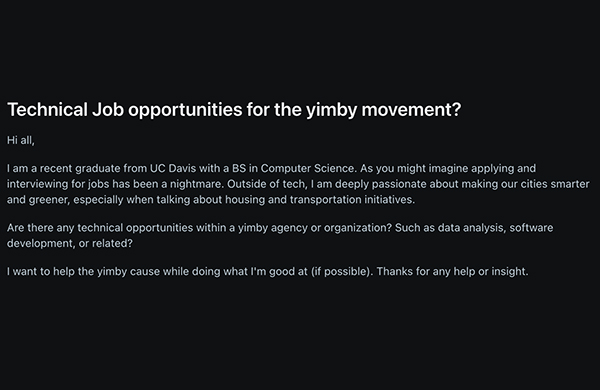
Guest Contributor: A.I.
What the f*#k is a software developer doing on a housing panel?
It’s not the kind of question I usually entertain, but when a friend sent it to me while scrolling through an event listing, I had to laugh. The event was a debate on whether the Province was justified in asserting its authority over local land-use decisions—a weighty, high-stakes topic with significant implications. And there it was: a software developer sharing the stage with individuals who seemed more directly connected to the issue
It turns out this isn’t as unusual as it might seem. Over the past decade, tech industry voices have become more prominent in housing debates, particularly on the pro-development side. While some of this involvement stems from genuine concern over affordability, the broader trend raises deeper questions about who truly benefits from this alliance. This shift isn’t accidental—it’s a deliberate move that deserves careful examination.
To understand how we got here, we must look back to the early 2010s, when a new wave of housing advocacy began gaining traction. In cities like San Francisco and New York, rising rents and restrictive zoning laws sparked a grassroots movement advocating for increased density and development. The movement, dubbed “Yes In My Backyard,” or YIMBY, aimed to counter opposition from “Not In My Backyard” (NIMBY) homeowners who resisted new housing projects.
The movement resonated with younger, urban renters hit hardest by housing shortages. In tech hubs like San Francisco, this included a significant number of tech workers. On the surface, it made sense: tech employees were often renters themselves, struggling with skyrocketing housing costs while watching zoning laws protect the wealth of homeowners. Early organizations like the San Francisco Bay Area Renters Federation rallied to push for policies allowing more housing in an attempt to level the playing field.
But as Patrick Range McDonald’s book Selling Off California: The Untold Story reveals, the story doesn’t end with grassroots activism. Instead, it takes a turn into something much more unsettling. According to McDonald, the tech industry’s involvement in housing advocacy wasn’t merely a benevolent response to the affordability crisis—it was largely driven by self-interest. This shift required a strategic alignment with political leaders and real estate developers, whose promises of affordable housing often exacerbated gentrification, displacement, and homelessness.
Critical to this story is California YIMBY—a nonprofit housing organization promoting land-use deregulation and widely seen as the face of the pro-development movement in the state. While the group presents itself as grassroots, its origins tell a different story. It was founded by two tech executives—Pantheon CEO Zack Rosen and Microsoft executive Nat Friedman—who hired Brian Hanlon to lead the organization and spearhead the growth of pro-development groups up and down California.
With millions of dollars in contributions, including funding from major tech companies and developers, California YIMBY and its political action committee, California YIMBY Victory Fund, gave campaign contributions to state politicians who aggressively advanced land-use deregulation and unfounded trickle-down housing agendas. This included key politicians like California State Treasurer Fiona Ma, California State Senator Toni Atkins, and California State Senator Scott Wiener—whose pro-development work with Los Angeles Mayor Eric Garcetti caused rents to soar and fueled displacement.
McDonald outlines how California YIMBY’s approach involved lobbying state legislators and drafting Big Tech-backed housing bills while deploying “ground troops” to counter housing and social justice activists. They mobilized support through extensive online platforms, often claiming to represent “young renters”—though the actual beneficiaries of their policies were frequently wealthier individuals and developers.
The non-profit status of California YIMBY adds another layer to the story. As a registered non-profit, the organization isn’t legally required to disclose its donors, making it difficult to trace the origins of its funding. While critics suspected real estate interests were among the funders, the lack of transparency allowed pro-development advocates to dismiss these allegations as baseless and speculative. This opacity shielded the influence of powerful interests, allowing them to operate under the guise of grassroots advocacy.
As McDonald’s investigation notes, the policies championed by California YIMBY benefitted developers and high-income renters while doing little to ensure the construction of affordable housing. By promoting deregulation and density near transit hubs, the organization catered to tech companies seeking to safeguard housing for their workers, but these policies also fueled gentrification and displacement. The alliances of tech, real estate, and political leaders created a system where those needing housing solutions were sadly left out of the equation.
The influence didn’t stop in California. Over time, this pro-development approach to housing and non-profit organizations spread along the West Coast and beyond, appearing in cities like Vancouver, where pro-development groups such as Abundant Housing Vancouver have gained prominence. Like California YIMBY, many members and volunteers of Abundant Housing groups have strong ties to the tech industry.
Abundant Housing is particularly interesting: it seems to operate as a part of a decentralized network of advocacy groups across several cities around the world—sharing strategies, resources, and narratives that echo California YIMBY’s approach.
Locally, we witnessed the extent to which an organization with ties to the tech industry, like Abundant Housing Vancouver, can gather support. Before a recent City of Vancouver public hearing focused on Broadway Plan rezonings, members and volunteers within the organization mobilized hundreds of short comments of support overnight through their online networks.
This raised questions about the coordination and scale of its networks, as well as the population that supports these pro-development causes. Those who don’t have access to computers or are less computer-savvy, like the elderly, for example, are excluded. Critics have also speculated that this kind of mobilization might involve support from across broader networks, but without transparency about funding or methods, it’s hard to say for sure.
What’s clear, however, is how powerful these online networks are. Vancouver’s public engagement systems, like those in many cities, lack the safeguards to detect or prevent potential manipulation. And when the same tech-savvy individuals shaping housing policy are also experts in digital systems, it’s easy to see how public processes might be influenced in hard-to-trace ways.
Consequently, Abundant Housing Vancouver members have found their way into various levels of government, from municipal committees to the Province’s “expert panel” on transit-oriented areas. So, critics are left wondering whether it’s a coincidence that communities are hearing the same narratives—claims of NIMBYism, trickle-down logic, etc.—coming out of the mouths of municipal officers, planners, and other political leaders. This has similarities to McDonald’s story.
This isn’t to suggest that Abundant Housing or other pro-development groups are part of some grand conspiracy. Many advocates genuinely believe in their cause. But McDonald’s work highlights an alarming pattern that he believes media should pay more attention to: the growing alignment between tech, real estate, and political leaders—three of the wealthiest, most influential organizations in the modern world. Together, these forces are reshaping cities in ways that often prioritize profit and growth over affordability and justice.
Another example of this is the recent Ontario case of Dream Unlimited: a Canadian landlord using AI software to suggest large rent increases. This tool is currently the subject of a U.S. government lawsuit for helping landlords coordinate pricing—recommending rent hikes higher than they would be without the software. This digital platform pushes landlords to prioritize revenue over tenant well-being. A software developer linked to the AI even admitted landlords had “too much empathy,” which the algorithm avoids.
Critics warn this practice worsens housing affordability and enables landlords to coordinate pricing, leaving tenants struggling with unsustainable rent increases. Tenants are protesting through rent strikes, demanding fairer practices and stricter rules to prevent landlords from using such software to inflate rents together.
This brings us back to my friend’s question: what is a software developer doing on a housing panel?
The answer, I think, is less about that individual and more about the larger story. As McDonald shows, the tech industry’s involvement in housing isn’t a coincidence. It’s a deliberate move to influence policies in ways that protect its interests, even if the policies exacerbate displacement and inequality.
So, the next time you notice a tech industry voice in housing discussions, consider the bigger picture. Instead of focusing on the individual, ask how and why their involvement reflects larger trends—and whose interests are being served.
In this story, the stakes go far beyond a single debate or city. They center on the critical question of who holds the power to shape the future of our communities and whose needs risk being overlooked.
***
For those interested in learning more about the Abundant Housing network, here are their websites:
- 2015 – Abundant Housing Los Angeles
- 2016 – Abundant Housing Vancouver
- 2020 – Abundant Housing Massachusetts
- 2022 – Abundant Housing Atlanta
- 2023 – Abundant Housing Network Australia
**
Click here to download a copy of Selling Off California by award-winning journalist Patrick Range McDonald.
*
A.I. is immersed in the tech industry and cares about cities.




